1. Braun J, Sieper J. Ankylosing spondylitis. Lancet. 2007; 369:1379–1390. PMID:
17448825.

2. Calin A, Fries JF. Striking prevalence of ankylosing spondylitis in "healthy" w27 positive males and females. N Engl J Med. 1975; 293:835–839. PMID:
126380.

3. Heeneman S, Daemen MJ. Cardiovascular risks in spondyloarthritides. Curr Opin Rheumatol. 2007; 19:358–362. PMID:
17551366.

4. Fisher LR, Cawley MI, Holgate ST. Relation between chest expansion, pulmonary function, and exercise tolerance in patients with ankylosing spondylitis. Ann Rheum Dis. 1990; 49:921–925. PMID:
2256739.

5. Kaya T, Gelal F, Gunaydin R. The relationship between severity and extent of spinal involvement and spinal mobility and physical functioning in patients with ankylosing spondylitis. Clin Rheumatol. 2006; 25:835–839. PMID:
16391887.

6. Kennedy LG, Jenkinson TR, Mallorie PA, Whitelock HC, Garrett SL, Calin A. Ankylosing spondylitis: the correlation between a new metrology score and radiology. Br J Rheumatol. 1995; 34:767–770. PMID:
7551663.

7. Viitanen JV, Heikkila S, Kokko ML, Kautiainen H. Clinical assessment of spinal mobility measurements in ankylosing spondylitis: a compact set for follow-up and trials? Clin Rheumatol. 2000; 19:131–137. PMID:
10791625.

8. Viitanen JV, Kokko ML, Lehtinen K, Suni J, Kautiainen H. Correlation between mobility restrictions and radiologic changes in ankylosing spondylitis. Spine (Phila Pa 1976). 1995; 20:492–496. PMID:
7747236.

9. Wanders A, Landewe R, Dougados M, Mielants H, van der Linden S, van der Heijde D. Association between radiographic damage of the spine and spinal mobility for individual patients with ankylosing spondylitis: can assessment of spinal mobility be a proxy for radiographic evaluation? Ann Rheum Dis. 2005; 64:988–994. PMID:
15958757.

10. Viitanen JV, Kokko ML, Heikkila S, Kautiainen H. Neck mobility assessment in ankylosing spondylitis: a clinical study of nine measurements including new tape methods for cervical rotation and lateral flexion. Br J Rheumatol. 1998; 37:377–381. PMID:
9619886.

11. Spoorenberg A, van der Heijde D, de Klerk E, Dougados M, de Vlam K, Mielants H, et al. Relative value of erythrocyte sedimentation rate and C-reactive protein in assessment of disease activity in ankylosing spondylitis. J Rheumatol. 1999; 26:980–984. PMID:
10229432.
12. Donath J, Miller A. Restrictive chest wall disorders. Semin Respir Crit Care Med. 2009; 30:275–292. PMID:
19452388.

13. Feltelius N, Hedenstrom H, Hillerdal G, Hallgren R. Pulmonary involvement in ankylosing spondylitis. Ann Rheum Dis. 1986; 45:736–740. PMID:
3767460.

14. Seçkin U, Bolukbasi N, Gursel G, Eroz S, Sepici V, Ekim N. Relationship between pulmonary function and exercise tolerance in patients with ankylosing spondylitis. Clin Exp Rheumatol. 2000; 18:503–506. PMID:
10949728.
15. Altin R, Ozdolap S, Savranlar A, Sarikaya S, Tor M, Kart L, et al. Comparison of early and late pleuropulmonary findings of ankylosing spondylitis by high-resolution computed tomography and effects on patients' daily life. Clin Rheumatol. 2005; 24:22–28. PMID:
15674655.

16. Baser S, Cubukcu S, Ozkurt S, Sabir N, Akdag B, Diri E. Pulmonary involvement starts in early stage ankylosing spondylitis. Scand J Rheumatol. 2006; 35:325–327. PMID:
16882601.

17. El Maghraoui A. Pleuropulmonary involvement in ankylosing spondylitis. Joint Bone Spine. 2005; 72:496–502. PMID:
16376803.

18. Ibn Yacoub Y, Amine B, Laatiris A, Abouqal R, Hajjaj-Hassouni N. Assessment of fatigue in Moroccan patients with ankylosing spondylitis. Clin Rheumatol. 2010; 29:1295–1299. PMID:
20803045.

19. Krupp LB, Pollina DA. Mechanisms and management of fatigue in progressive neurological disorders. Curr Opin Neurol. 1996; 9:456–460. PMID:
9007405.

20. Swain MG. Fatigue in chronic disease. Clin Sci (Lond). 2000; 99:1–8. PMID:
10887052.

21. Calin A, Edmunds L, Kennedy LG. Fatigue in ankylosing spondylitis: why is it ignored? J Rheumatol. 1993; 20:991–995. PMID:
8350337.
22. Jones SD, Koh WH, Steiner A, Garrett SL, Calin A. Fatigue in ankylosing spondylitis: its prevalence and relationship to disease activity, sleep, and other factors. J Rheumatol. 1996; 23:487–490. PMID:
8832988.
23. Dagfinrud H, Vollestad NK, Loge JH, Kvien TK, Mengshoel AM. Fatigue in patients with ankylosing spondylitis: a comparison with the general population and associations with clinical and self-reported measures. Arthritis Rheum. 2005; 53:5–11. PMID:
15696569.

24. van Tubergen A, Coenen J, Landewe R, Spoorenberg A, Chorus A, Boonen A, et al. Assessment of fatigue in patients with ankylosing spondylitis: a psychometric analysis. Arthritis Rheum. 2002; 47:8–16. PMID:
11932872.

25. Bodur H, Ataman S, Rezvani A, Bugdayci DS, Cevik R, Birtane M, et al. Quality of life and related variables in patients with ankylosing spondylitis. Qual Life Res. 2011; 20:543–549. PMID:
20978859.

26. Vesovic-Potic V, Mustur D, Stanisavljevic D, Ille T, Ille M. Relationship between spinal mobility measures and quality of life in patients with ankylosing spondylitis. Rheumatol Int. 2009; 29:879–884. PMID:
19172276.

27. van der Linden S, Valkenburg HA, Cats A. Evaluation of diagnostic criteria for ankylosing spondylitis: a proposal for modification of the New York criteria. Arthritis Rheum. 1984; 27:361–368. PMID:
6231933.
28. Ware JE, Kosinski M, Dewey JE, Gandek B. SF-36 health survey: manual and interpretation guide. Lincoln: Quality Metric Inc.;2000.
29. Wei JC, Wong RH, Huang JH, Yu CT, Chou CT, Jan MS, et al. Evaluation of internal consistency and re-test reliability of Bath ankylosing spondylitis indices in a large cohort of adult and juvenile spondylitis patients in Taiwan. Clin Rheumatol. 2007; 26:1685–1691. PMID:
17286214.

30. Calin A, Nakache JP, Gueguen A, Zeidler H, Mielants H, Dougados M. Defining disease activity in ankylosing spondylitis: is a combination of variables (Bath Ankylosing Spondylitis Disease Activity Index) an appropriate instrument? Rheumatology (Oxford). 1999; 38:878–882. PMID:
10515650.

31. Garrett S, Jenkinson T, Kennedy LG, Whitelock H, Gaisford P, Calin A. A new approach to defining disease status in ankylosing spondylitis: the Bath Ankylosing Spondylitis Disease Activity Index. J Rheumatol. 1994; 21:2286–2291. PMID:
7699630.
32. Calin A, Garrett S, Whitelock H, Kennedy LG, O'Hea J, Mallorie P, et al. A new approach to defining functional ability in ankylosing spondylitis: the development of the Bath Ankylosing Spondylitis Functional Index. J Rheumatol. 1994; 21:2281–2285. PMID:
7699629.
33. Belza BL, Henke CJ, Yelin EH, Epstein WV, Gilliss CL. Correlates of fatigue in older adults with rheumatoid arthritis. Nurs Res. 1993; 42:93–99. PMID:
8455994.

34. Belza BL. Comparison of self-reported fatigue in rheumatoid arthritis and controls. J Rheumatol. 1995; 22:639–643. PMID:
7791155.
35. Aissaoui N, Rostom S, Hakkou J, Berrada Ghziouel K, Bahiri R, Abouqal R, et al. Fatigue in patients with ankylosing spondylitis: prevalence and relationships with disease-specific variables, psychological status, and sleep disturbance. Rheumatol Int. 2012; 32:2117–2124. PMID:
21516494.

36. Creemers MC, Franssen MJ, van't Hof MA, Gribnau FW, van de Putte LB, van Riel PL. Assessment of outcome in ankylosing spondylitis: an extended radiographic scoring system. Ann Rheum Dis. 2005; 64:127–129. PMID:
15051621.

37. Berdal G, Halvorsen S, van der Heijde D, Mowe M, Dagfinrud H. Restrictive pulmonary function is more prevalent in patients with ankylosing spondylitis than in matched population controls and is associated with impaired spinal mobility: a comparative study. Arthritis Res Ther. 2012; 14:R19. PMID:
22277377.

38. Dincer U, Cakar E, Kiralp MZ, Bozkanat E, Kilac H, Dursun H. The pulmonary involvement in rheumatic diseases: pulmonary effects of ankylosing spondylitis and its impact on functionality and quality of life. Tohoku J Exp Med. 2007; 212:423–430. PMID:
17660708.

39. Solak O, Fidan F, Dundar U, Turel A, Aycicek A, Kavuncu V, et al. The prevalence of obstructive sleep apnoea syndrome in ankylosing spondylitis patients. Rheumatology (Oxford). 2009; 48:433–435. PMID:
19223282.

40. Ozdem Yr O, Inanici F, Hascelik Z. Reduced vital capacity leads to exercise intolerance in patients with ankylosing spondylitis. Eur J Phys Rehabil Med. 2011; 47:391–397. PMID:
21364507.
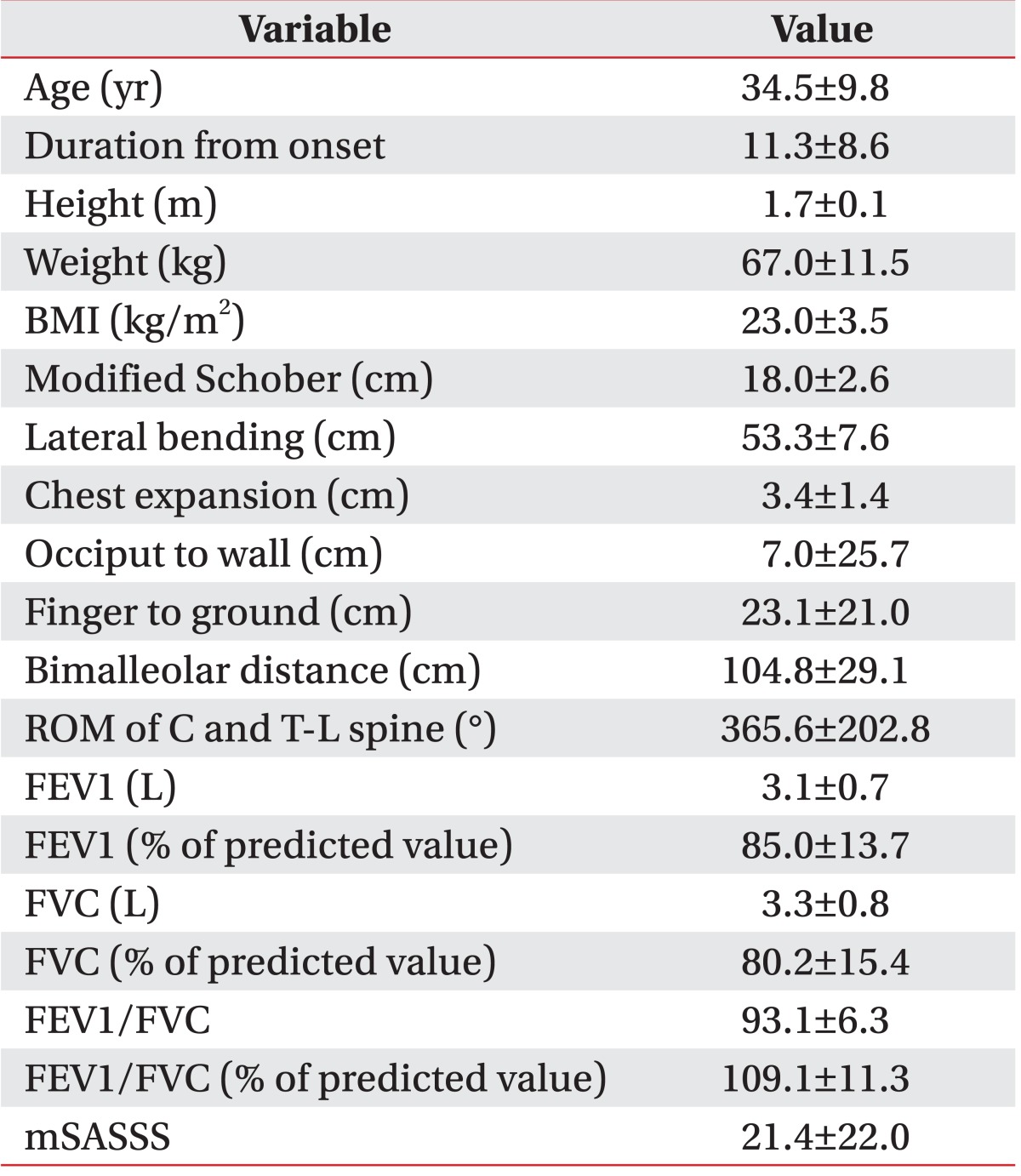
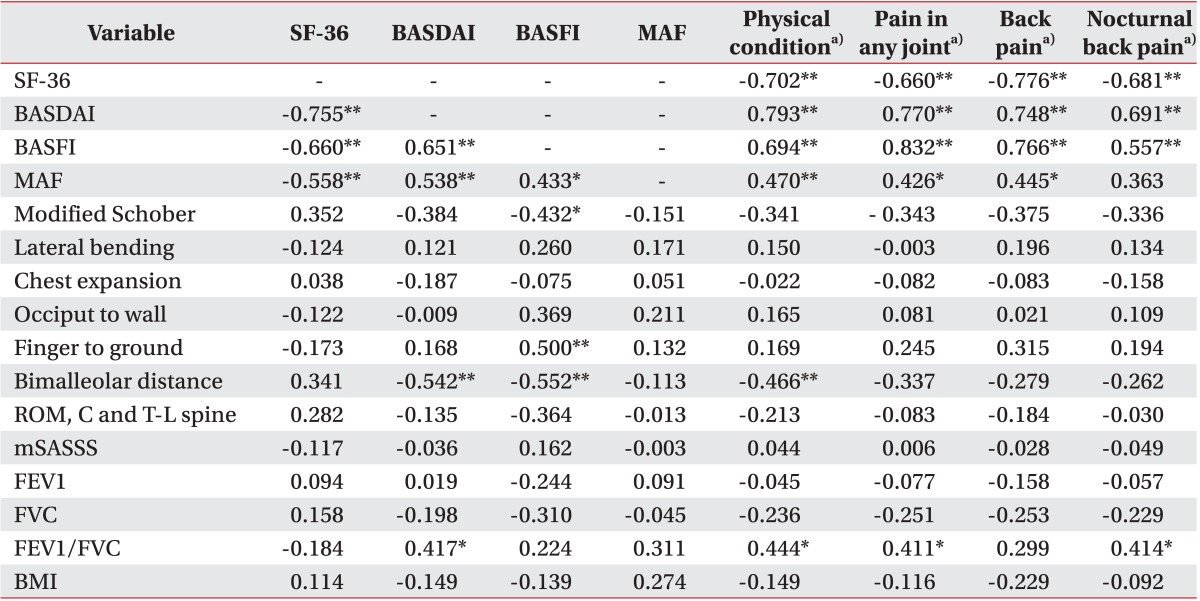




 PDF
PDF ePub
ePub Citation
Citation Print
Print


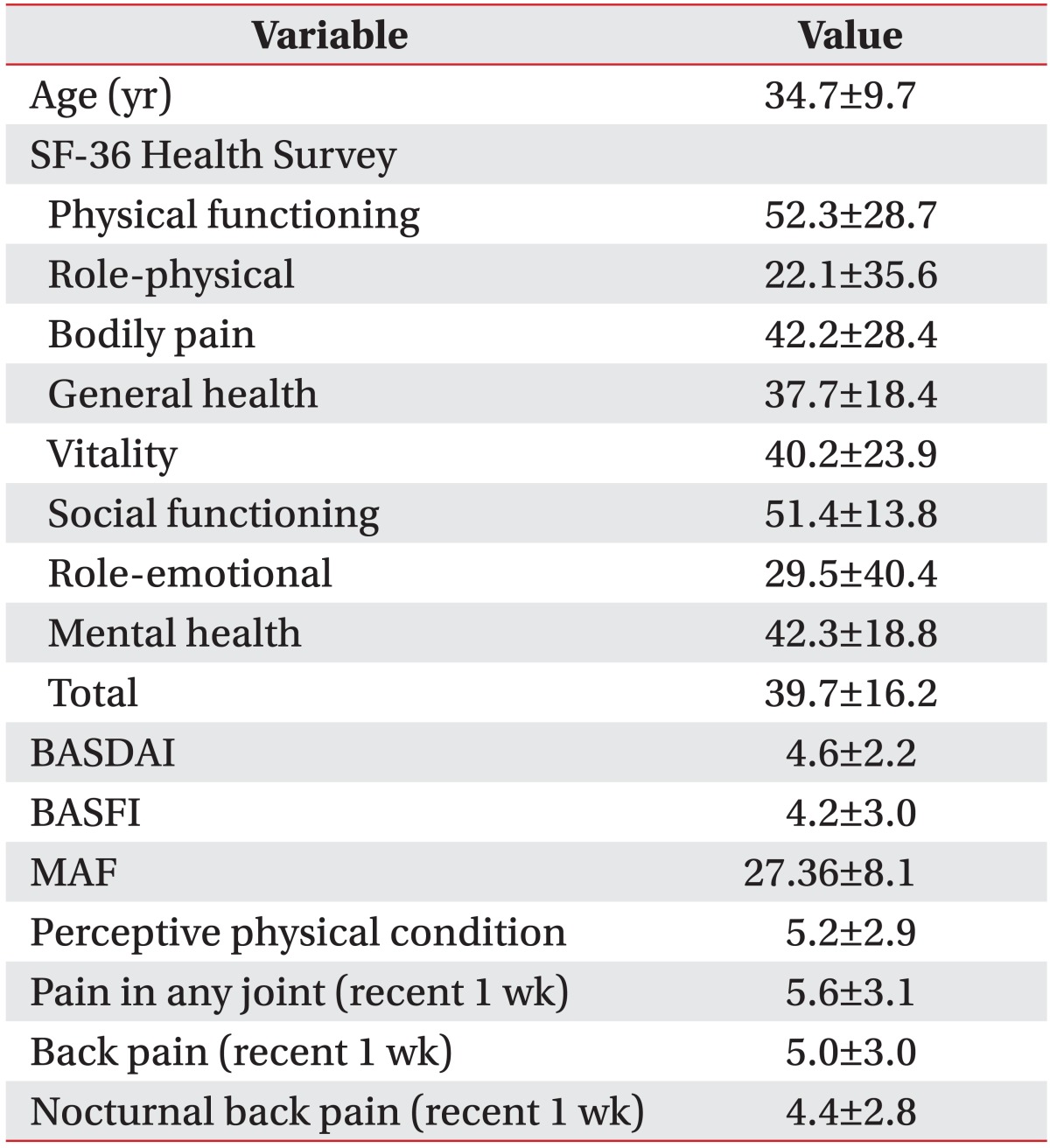
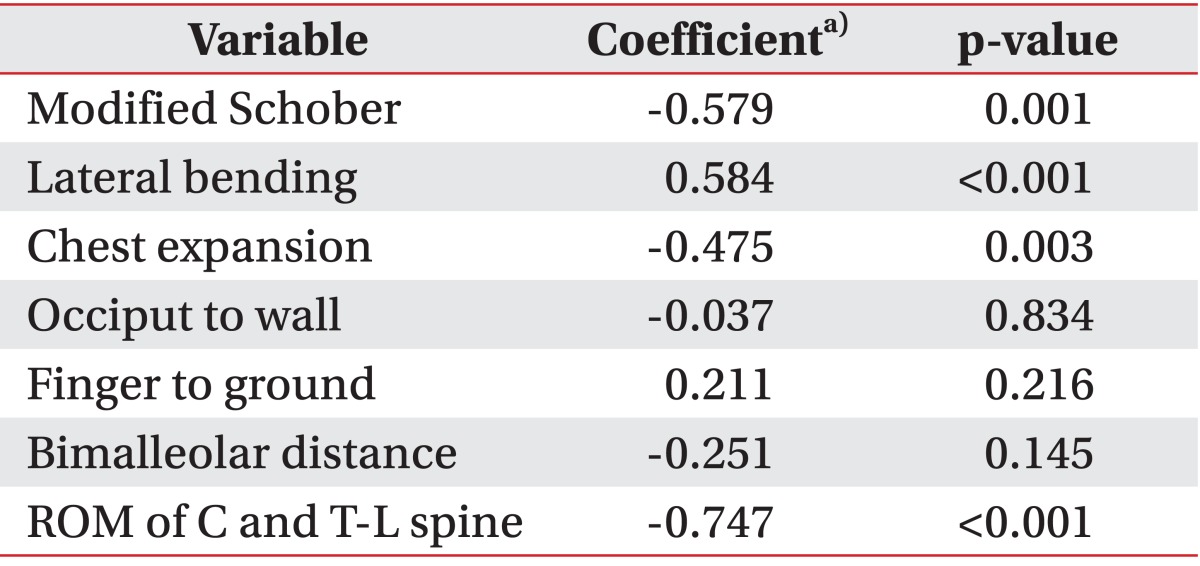
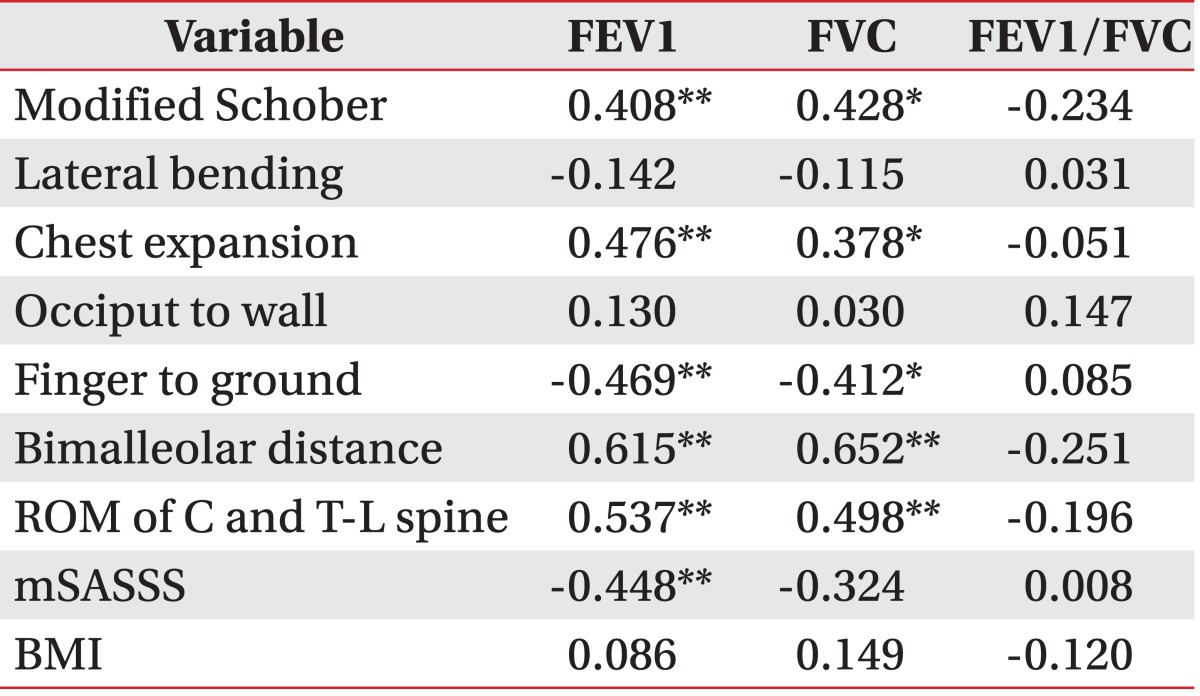
 XML Download
XML Download